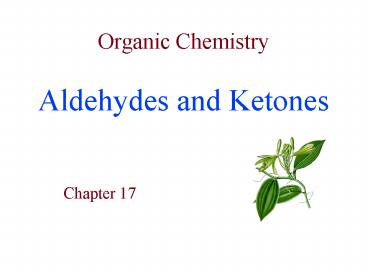Organic Chemistry Aldehydes and Ketones - PowerPoint PPT Presentation
1 / 43
Title:
Organic Chemistry Aldehydes and Ketones
Description:
Organic Chemistry Aldehydes and Ketones Chapter 17 Formation of Acetals Hemiacetal reactions (formation of hemiacetals) likely when within the same molecule 1o ... – PowerPoint PPT presentation
Number of Views:112
Avg rating:3.0/5.0
Title: Organic Chemistry Aldehydes and Ketones
1
Organic ChemistryAldehydes and Ketones
- Chapter 17
2
Aldehydes and Ketones
- Carbonyl Group CO
- Present in aldehydes and ketones
Aldehydes
Ketones
3
Aldehydes
- Aldehydes
- Sometimes abbreviated RCHO
- Contain at least one H connected to the C
Aldehydes
4
Ketones
- Ketones
- Carbonyl C is connected to two alkyl groups
- RCOR
Ketones
5
Nomenclature
- IUPAC
- Suffix is -al for the aldehydes
- Suffix is -one for the ketones
- indicates position of ketone
6
Nomenclature
NOTE Ketone, Not keytone
From Yahoo Images
7
Nomenclature
- An Aldehyde or Ketone takes precedence over any
previously considered group
8
Nomenclature
- Common names - aldehydes
9
Nomenclature
- Common names - ketones
- Some are always used
- Others name each R group and end with ketone
10
Physical Properties
- Carbonyls
- Cannot form H bonding with each other
- There is NOT an H connected to a F, N, O
- Aldehydes and Ketones are POLAR molecules and
form dipole interactions - Gives higher boiling and melting points
11
Physical Properties
- Aldehydes and Ketones
- can form H bonds with water!
- solubility in water is about the same as alcohols
yes!
12
Physical Properties
- Strong odors
- Ketones generally have pleasant odors
- perfumes, flavoring agents
- Aldehydes odors vary
- some pleasant
- cinnaminaldehyde, vanillin
- some not pleasant
- formaldehyde
- Many are found in natural products
http//www.youtube.com/watch?vKDohVakqkic
13
How do you make Aldehydes?
- Aldehydes from Oxidation of 1o alcohols
- Problem is over oxidation to ACID!
Practice a couple ..
14
How do you make Ketones?
- Ketones from Oxidation of 2o alcohols
Practice a couple ..
15
Oxidation of Aldehydes
- Aldehydes are easily oxidized
- KMnO4
- K2Cr2O7
- even air oxidation carboxylic acid!
16
Oxidation of Ketones
- Ketones resist oxidation
- under mild or normal conditions, no reaction
- more severe conditions yield mixtures
- CO2 and H2O under extreme conditions
This difference in reactivity can be used to
Tell the difference between an aldehyde and
ketone
17
(No Transcript)
18
Reaction
- 1. Oxidation Tollens Test
- - Benedicts Test
- 2. Reduction Hydrogen addition
- NaBH4 reagent
- 3. Addition of Alcohols hemiacetal/acetal
- and tautomerism
19
Tollens Test
- The Silver Mirror Test
- Oxidation of Aldehydes
- Ag ion in aq. ammonia
- NO reaction with KETONES
- Ag(NH3)2 aldehyde
Silver Mirror
Ag 2 NH3 Ag(NH3)2
Ag(NH3)2 RCHO Ago RCOO- 4NH3
20
Benedicts Test
- Oxidation of Aldehydes
- Cu ion, aqueous
- Orange to red ppt.
- NO reaction with KETONES
Cu aldehyde Cu(oxide)
acid
21
Benedicts Test
- Oxidation of Aldehydes
- overall reaction
22
Chemical Properties
- Addition to CO
- Other reactions are ADDITION Reactions
- Bond is polar ? and ?-
- Negatives are attracted to C
- Positives are attracted to O
-
B
23
Addition of H2
- Reduction to Alcohols
- Hydrogen gas and a catalyst (Ni, Pd, Pt)
- Similar to alkene to alkane reduction
B
24
Addition of H2
- Reduction to Alcohols
- Will reduce ketones to 2o alcohols
- Slower reaction than reduction of CC
- CC is reduced faster (first) if both CO and CC
B
25
Addition of H2 using NaBH4
- Reduction to Alcohols
- NaBH4 does not allow the reaction of the carbon
carbon double bond
B
26
Addition of Alcohol
- In the addition of R-OH to form an acetal the
First step is the formation of a hemiacetal - This is when an -OH and -OR are both on same C
B
27
Formation of Acetals
- IF strong acid (HCl) is present, a second alcohol
reacts to form the acetal (two -OR groups on C)
H2O
B
28
Addition of Alcohol - Acetals
Step 1
Step 2
H2O
B
29
Formation of Acetals
- Addition of R-OH
- acid catalyzed, 2 moles of alcohol react
?
B
30
Formation of Acetals
- Addition of R-OH
- acid catalyzed, 2 moles of alcohol react
Draw the Hemi
B
31
Formation of Acetals
- Acetal reaction in equilibrium
B
32
Formation of Acetals
- Acetal reactions
?
B
33
Formation of Acetals
- Acetal reactions
?
1o alcohol
B
34
Formation of Acetals
- Hemiacetal reactions (formation of hemiacetals)
- likely when within the same molecule
1o alcohol
B
35
Formation of Acetals
- Cyclic hemiacetals
- Reacts with a 2nd. molecule of alcohol
- Results in a cyclic acetal
1o alcohol
B
36
Formation of Acetals
- Which are hemiacetals / acetals?
1
2
3
4
5
6
7
8
9
10
B
37
Keto-Enol Tautomerism
- Equilibrium that exists
- Keto (carbonyl) to Enol (alkene/alcohol)
B
38
Keto-Enol Tautomerism
- Equilibrium called Tautomerism
1o alcohol
B
39
Keto-Enol Tautomerism
- Equilibrium called Tautomerism
Most enols are less stable
1o alcohol
B
40
Important Compounds
- Formaldehyde
- Gas at RT
- Soluble in H2O
- Formalin
- 37 formaldehyde
- found in labs
- preserves by denaturing proteins
- Used to produce polymers
B
41
Important Compounds
- Acetaldehyde
- bp 21o C
- Converted to trimer
- 3 units of acetaldehyde
- called paraldehyde
- once used as a hypnotic/sleep-producer
B
42
Important Compounds
- Acetone
- bp 56o C
- Infinitely soluble in H2O
- Excellent industrial solvent
- paints, varnishes, resins
- coatings, nail polish
- Produced in the body
- diabetic ketoacidosis
- acetone breath
B
43
Important Compounds
- ?-chloroacetophenone
- lachrymators
- tearing of eyes, etc.
- Used as a tear gas
- Active ingredient in Mace
B































